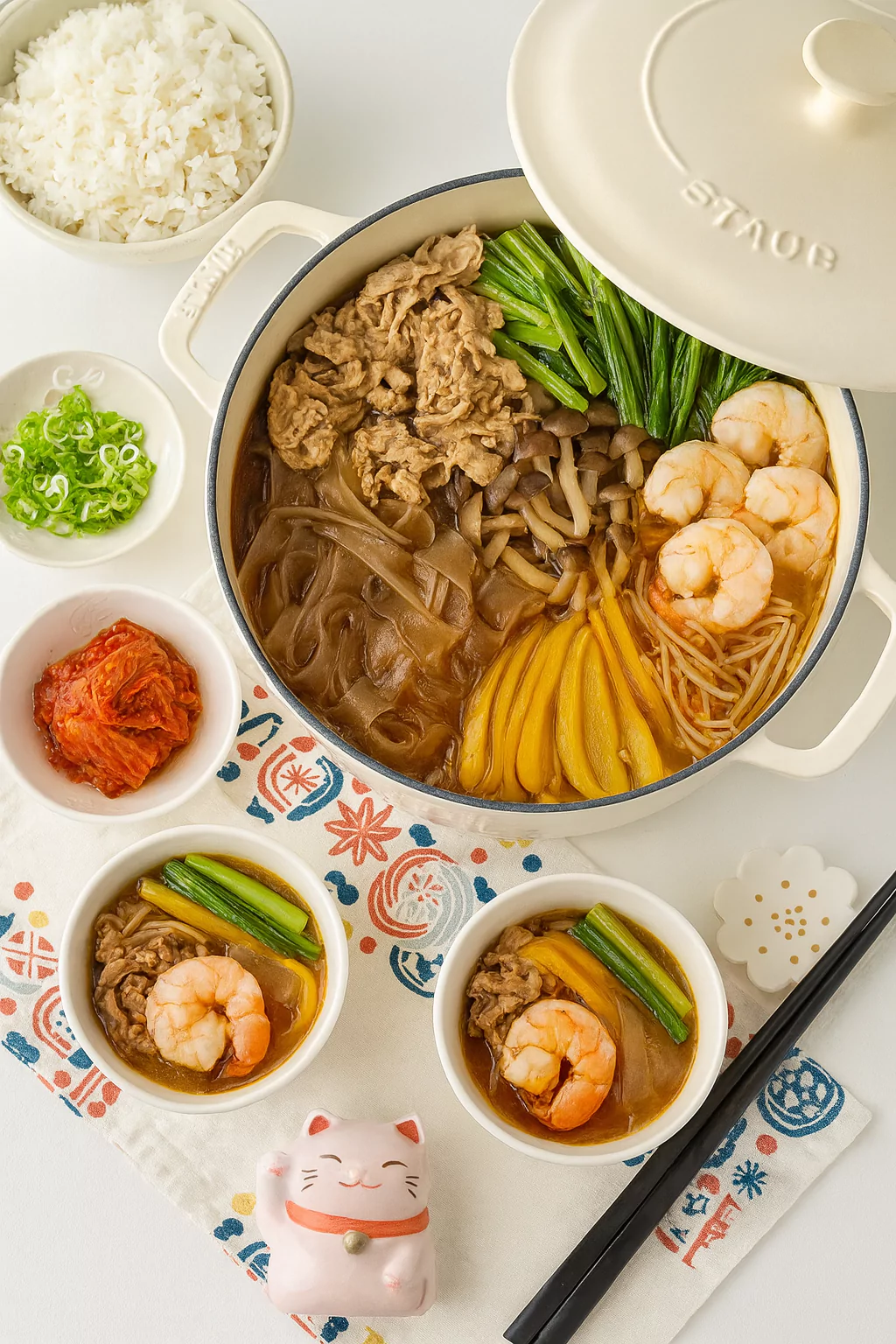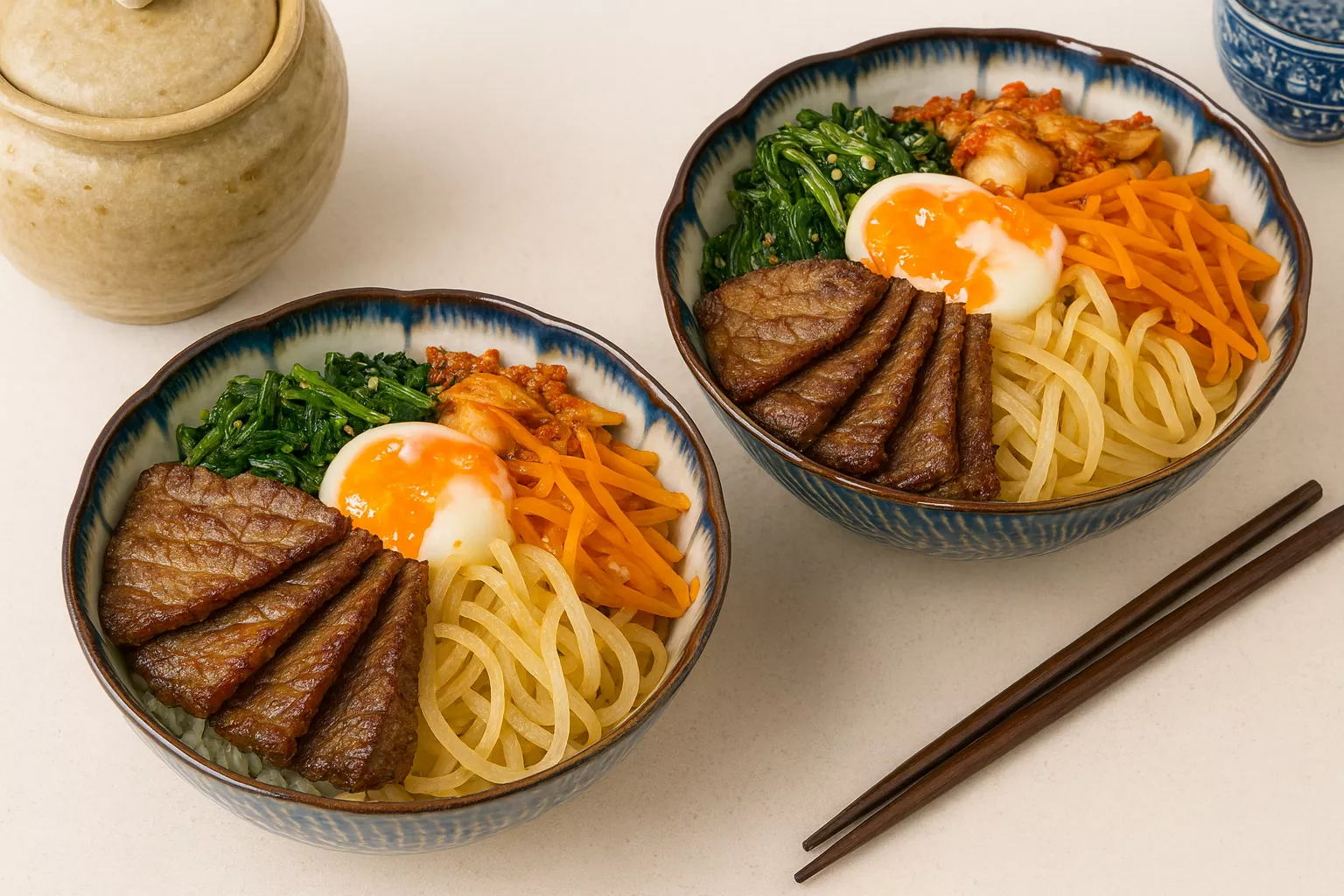Have you ever wondered why one simple bowl can feel so comforting, colorful, and full of flavor at the same time? Many people think a beautiful rice bowl takes hours to prepare or needs complicated ingredients, but this recipe proves the opposite. A Bibimbap-style bowl, also known as ビビンバ風ボウル in Japanese, is one of the easiest and most satisfying dishes you can make at home. Once you see how simple the steps are, you may start making this bowl again and again.
This guide walks you through how to prepare a Bibimbap-style bowl that is quick, healthy, and packed with delicious textures—crispy, tender, warm, and fresh all in one. Each ingredient plays an important role, and the best part is that you can adjust everything to your taste.
What Makes This Recipe Special
This Bibimbap-style bowl is inspired by the classic Korean dish Bibimbap, but prepared in a simple, home-friendly way. The result is a colorful and balanced meal with seasoned vegetables, tender beef, kimchi, and a soft-boiled egg on top of warm rice.
This dish stands out because:
- It is easy enough for beginners.
- It comes together in about 25 to 30 minutes.
- It uses everyday ingredients.
- It offers both rich flavor and healthy nutrition.
- It is perfect for lunch, dinner, or meal prep.

Bibimbap-style Bowl ビビンバ風ボウル @JapanDishes
What Is a Bibimbap-style Bowl?
A Bibimbap-style bowl, or ビビンバ風ボウル, is a rice bowl topped with seasoned vegetables known as namul, grilled or stir-fried meat, spicy kimchi, and a soft-boiled egg. The meaning of bibimbap comes from “mixing rice,” and that is what makes it fun. You combine several toppings in one bowl, then mix everything together before eating.
This style of bowl has become popular in Japan because it is quick, healthy, and very customizable. The Japanese-inspired version focuses on mild seasoning, simple steps, and a beautiful arrangement of ingredients.
Key Ingredients (材料)
Bibimbap-style BowlThese ingredients give your Bibimbap-style bowl (ビビンバ風ボウル) its color, aroma, and balance. Each card shows what the ingredient does in the bowl and how you can easily swap it.
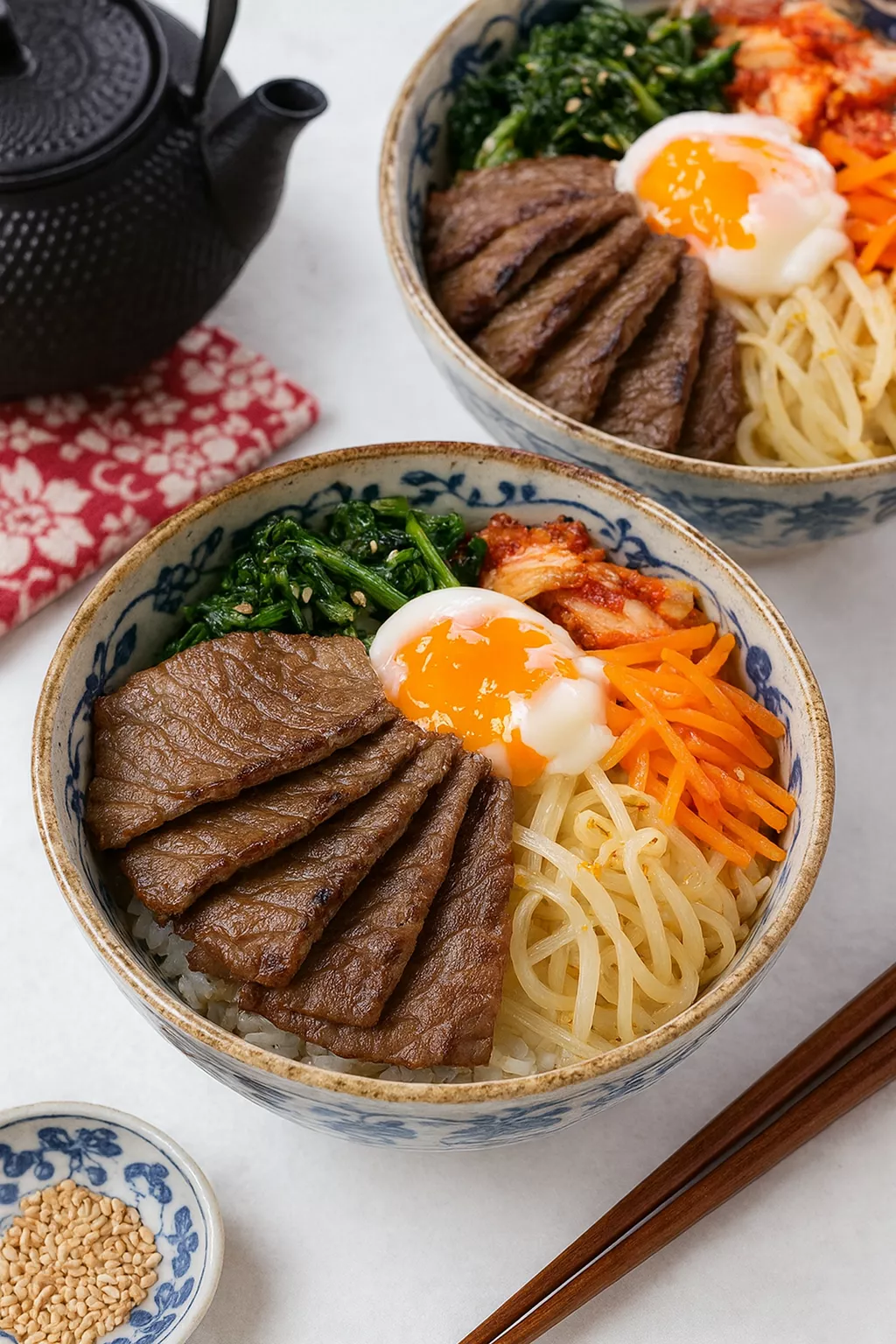
Ingredient Variations
You can also add:
- Zucchini sautéed lightly
- Sliced cucumbers
- Shiitake mushrooms
- Gochujang sauce
- Seaweed strips
- Soy-marinated tofu
This recipe is flexible, and you can mix your favorite ingredients to make your own special version.
Step-by-Step Instructions
Below is a clear and easy guide to preparing your Bibimbap-style bowl in just five main steps. Each step is simple, and the toppings can be made ahead of time.
Step 1: Make the Bean Sprout Namul
Wash the bean sprouts and place them in a heat-safe bowl. Cover them with plastic wrap and microwave for two minutes at 600W. After heating, drain any water that collects in the bowl. Then season the sprouts with a small amount of chicken stock powder, sesame oil, and roasted white sesame seeds. Mix gently so the flavor spreads evenly.
This will create a lightly seasoned, aromatic side that adds freshness to the bowl.

Step 2: Prepare the Carrot Namul
Shred the carrots into thin strips and place them in another heat-safe bowl. Cover with plastic wrap and microwave for two minutes at 600W. After heating, drain any excess liquid. Season with chicken stock powder, sesame oil, and sesame seeds. Mix well to coat.
The carrots will become tender, sweet, and lightly seasoned with a nutty aroma.

Step 3: Cook the Spinach Namul
Rinse the spinach and cut it into pieces about three centimeters long. Boil a pot of water and cook the spinach for two minutes. Drain and rinse under cold water to remove bitterness and keep the bright color. Squeeze gently to remove excess water.
Transfer to a bowl and season with chicken stock powder, sesame oil, and roasted sesame seeds. Mix until combined.
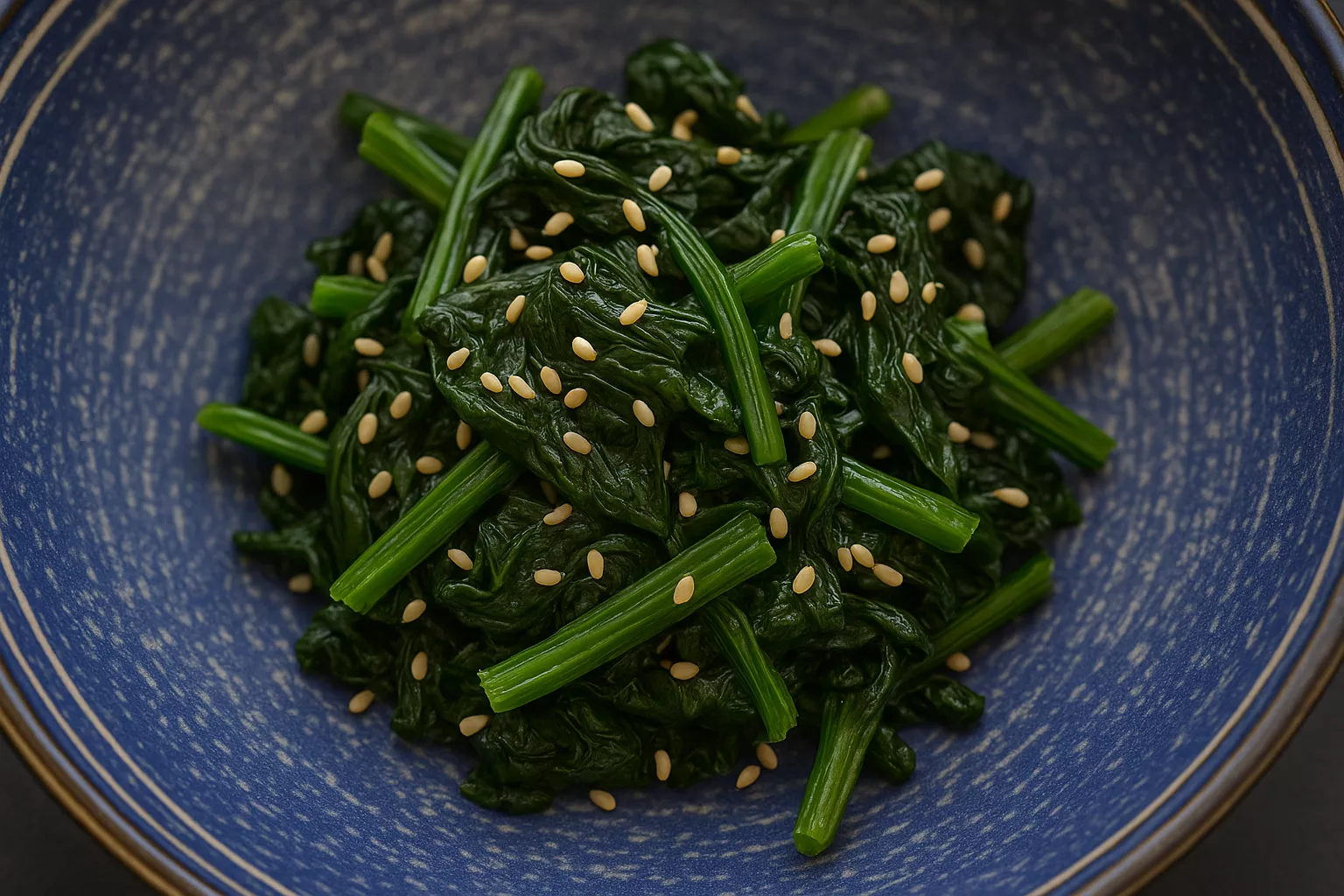
Step 4: Cook the Yakiniku Beef
Heat a small amount of sesame oil in a frying pan. Add the beef slices and cook quickly on both sides. When the meat is lightly browned, remove from the pan and coat it evenly with yakiniku sauce. The warm meat will soak up the sauce and become juicy and flavorful.
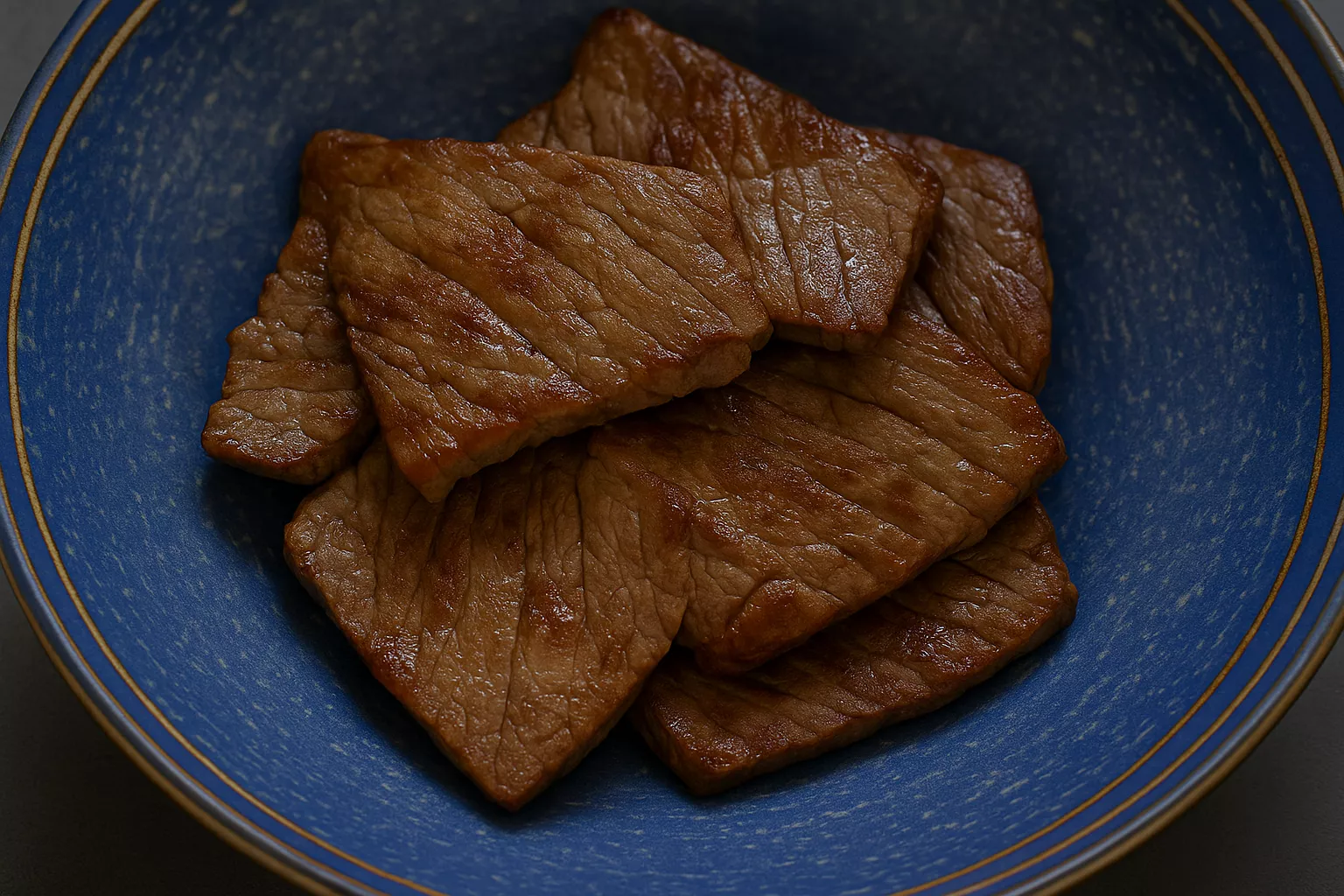
Step 5: Assemble the Bowl
Place warm rice into two serving bowls. Arrange the three kinds of namul, the seasoned beef, and a spoonful of kimchi around the rice in a circular pattern. Place a soft-boiled egg right in the center.
Your Bibimbap-style bowl is ready to enjoy.

Secrets to Success and Expert Tips
Use these simple tips to make your Bibimbap-style bowl even more delicious and well balanced:
-
♥
Keep each namul lightly seasoned
The vegetables should taste fresh, not too salty. Light seasoning helps the flavors blend well when mixed with the rice and egg. -
♥
Do not overcook the vegetables
Carrots and bean sprouts taste best when they keep a bit of crunch. Heating them just enough keeps their color bright and texture perfect. -
♥
Cool the spinach quickly
Rinse the spinach under cold water after boiling. This removes bitterness and helps the leaves stay a clean, vibrant green. -
♥
Sear the beef fast over high heat
Yakiniku beef cooks in seconds. High heat keeps it juicy, while quick searing helps the sauce cling better to the meat. -
♥
Use warm rice for the final bowl
Warm rice helps melt the soft-boiled egg and blend the flavors smoothly once everything is mixed together. -
♥
Mix just before eating
Keeping the ingredients separated in the bowl makes it look beautiful. Mix everything well only when you are ready to eat for the best flavor and texture.
Assembly Guide and Presentation Tips
The beauty of a Bibimbap-style bowl lies in the way the ingredients are arranged. Presentation is simple, but small touches can make it look impressive.
How to Assemble
- Add warm rice to the bowl.
- Place each namul in its own section.
- Add the beef in one area and kimchi in another.
- Put the soft-boiled egg right in the center.
- Sprinkle extra sesame seeds on top if you like.
Presentation Tips
- Contrast colors: orange carrots, green spinach, white sprouts, red kimchi.
- Keep toppings separated until mixing.
- Use a deep bowl to help the ingredients sit neatly.
- Add a small drizzle of sesame oil before serving for extra aroma.

Hana’s Recipe Tips
To make your bowl even more special, try these ideas:
- Prepare the vegetables earlier in the day and chill them. They stay crisp and fresh.
- Add a spicy sauce on the side so people can adjust the heat level.
- Use Japanese-style rice for the best texture.
- When making soft-boiled eggs, cook for six minutes for a creamy center.
- If you want richer flavor, warm the yakiniku sauce slightly before coating the meat.
Storage and Make-Ahead Tips
Bibimbap-style bowls are perfect for meal prep because many parts can be stored separately.
How to Store
- Namul vegetables: Store in airtight containers in the refrigerator for up to three days.
- Cooked beef: Keep in a sealed container for two days.
- Rice: Best eaten fresh, but you can store it for one day and reheat with a splash of water.
- Soft-boiled eggs: Store unpeeled for up to two days.
Reheating Tips
- Warm the beef lightly in a pan or microwave.
- Reheat rice until soft.
- Serve vegetables cold or at room temperature.
- Add the egg last to keep its soft texture.
Recipe Variations
This Bibimbap-style bowl (ビビンバ風ボウル) is very flexible, and you can adjust the ingredients to match your taste, dietary needs, or whatever you have in your kitchen:
Add Protein
Customize the bowl by swapping the beef with other protein options:
- Pan-fried tofu for a vegetarian version
- Sliced chicken cooked in soy sauce
- Stir-fried mushrooms such as shiitake or enoki
Swap the Vegetables
Use different vegetables if you want more color or crunch:
- Zucchini, lightly sautéed
- Cucumber slices for a fresh touch
- Purple cabbage for extra color and texture
Make It Spicy
Add heat if you enjoy a spicy Bibimbap-style bowl:
- A spoonful of gochujang mixed into the rice
- A drizzle of chili oil on top
- Red pepper flakes sprinkled over the vegetables
Change the Base
You don’t have to use white rice—try other bases for a different taste or texture:
- Brown rice for more fiber
- Mixed grain rice for a nutty flavor
- Cauliflower rice for a lighter, low-carb bowl
More Japanese Recipes You May Like
If you enjoy making this Bibimbap-style bowl, you may also like exploring other comforting Japanese dishes on JapanDishes. For a warm and satisfying noodle dish, try the Beef Udon recipe.
If you prefer something light with plenty of vegetables, you can read this Stewed Glass Noodles recipe. Both recipes pair perfectly with this bowl and offer more delicious ideas for your table.
Conclusion
A Bibimbap-style bowl is simple, colorful, and satisfying. With soft vegetables, juicy beef, spicy kimchi, and creamy egg, each bite is full of comfort and flavor. The best part is how flexible this dish is. You can adjust every ingredient to fit your taste or use what you already have at home.
If you want a quick, healthy, and flavorful bowl that looks beautiful and tastes even better, this recipe is a perfect choice. Try making your own version and enjoy how easy it is to create a delicious meal in one bowl.
Frequently Asked Questions
1. Can I make this bowl without beef?
Yes. You can use chicken, tofu, mushrooms, or even fish. The bowl stays balanced and tasty with any protein.
2. Can I make the vegetables ahead of time?
Yes. The namul keeps well for up to three days. Store them in airtight containers.
3. Is a Bibimbap-style bowl healthy?
Yes. It includes vegetables, protein, and rice, making it balanced and rich in nutrients.
4. How do I get the perfect soft-boiled egg?
Boil for six minutes, then place the eggs in cold water to stop cooking. Peel carefully.
5. Can I use brown rice?
Yes. Brown rice adds more fiber and works very well with the toppings.
6. How spicy is this recipe?
The heat level depends on the kimchi and whether you add extra sauce. You can keep it mild or make it spicy.
7. Can I make this for meal prep?
Yes. Store each component separately and assemble when ready to eat.
Bibimbap-style bowl ビビンバ風ボウル
Course: Main CoursesCuisine: JapaneseDifficulty: Easy2
servings15
minutes15
minutes450–550
kcalThis Bibimbap-style bowl is a simple, colorful, and satisfying rice bowl made with seasoned vegetables, juicy yakiniku beef, kimchi, and a soft-boiled egg. It takes only a few steps to prepare and brings together warm rice, fresh namul, and rich flavors for a balanced and comforting meal.
Ingredients
Yakiniku beef – 150g
Sesame oil – a little, for cooking
Yakiniku sauce – 1 tablespoon or more
Cooked rice – enough for 2 bowls
Kimchi – as needed
Soft-boiled eggs – 2 pieces
Bean sprouts – 100g
Chicken stock powder – 1/4 teaspoon
Sesame oil – 1/2 teaspoon
Roasted white sesame seeds – 1/2 teaspoon
Carrots – 60g
Chicken stock powder – 1/4 teaspoon
Sesame oil – 1/2 teaspoon
Roasted white sesame seeds – 1/2 teaspoon
Spinach – 100g
Chicken stock powder – 1/4 teaspoon
Sesame oil – 1/2 teaspoon
Roasted white sesame seeds – 1/2 teaspoon
Directions
- Prepare the bean sprout namul
Rinse the bean sprouts and place them in a heat-safe bowl. Cover with plastic wrap and microwave for about 2 minutes at 600W. Drain any liquid that collects in the bowl, then mix in chicken stock powder, sesame oil, and roasted sesame seeds. Stir until well coated. - Make the carrot namul
Shred the carrots into thin strips and put them in another heat-safe bowl. Cover and microwave for 2 minutes at 600W. Drain away moisture, then season with chicken stock powder, sesame oil, and roasted sesame seeds. Stir to combine. - Cook the spinach namul
Wash the spinach and cut into short pieces. Boil for 2 minutes, then quickly cool under cold running water to keep the color bright. Squeeze out extra water, place in a bowl, and season with chicken stock powder, sesame oil, and roasted sesame seeds. - Cook the yakiniku beef
Heat a little sesame oil in a frying pan. Add the sliced beef and sear it quickly on both sides until lightly browned. Remove from the heat and coat the beef with yakiniku sauce while still warm. - Assemble the Bibimbap-style bowl
Scoop warm rice into two serving bowls. Arrange the three types of namul, the cooked beef, and some kimchi neatly on top of the rice. Place a soft-boiled egg in the center. Serve as is or mix everything together before eating.
Notes
- You can prepare the namul ahead of time and store them in the refrigerator for up to three days.
- For extra flavor, drizzle a little sesame oil on top before serving.
- You can also swap the beef with chicken, tofu, or mushrooms to make your own version of this bowl.
Did you make this recipe?
Tag @jp.dishes on Instagram so we can see your delicious creation!


